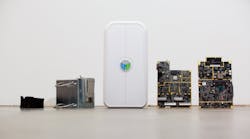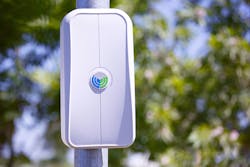For years, Facebook has handed out its software to developers in attempts to quickly refine its internet services. But the social media company has also used this open-source model to steer hardware markets in new directions. Its efforts began in 2012 with the Open Compute Project, in which Facebook shared its custom server designs with hardware makers like Intel and Hewlett-Packard.
By partnering with hardware and cloud computing companies, Facebook bet that the new equipment would be easier to reprogram and to expand its sprawling data centers. Lately, Facebook has applied this model to wireless hardware, in an attempt to bring cellular and internet service to remote locations that might not have access to the social media site.
Facebook recently revealed the plan’s latest building block: A new device called OpenCellular that allows wireless carriers to bring connectivity to places lying outside the reach of cell towers. The small device, which can be attached to telephone poles or tree trunks, contains processors and storage capacity to support wireless networks.
According to Facebook, the new device is aimed at extending broadband service to the roughly 4 billion people isolated from the internet at the end of 2015. The company estimated that about 10% of the world’s population lived outside the range of cellular connectivity in 2015.
“One of the reasons the expansion of cellular networks has stalled is that the ecosystem is constrained,” said Kashif Ali, an engineer working on the project, in a blog post. OpenCellular, on the other hand, includes “architectural and design improvements that would result in lower costs associated with the civil and support infrastructure.”
It almost resembles a small cell, said Sue Rudd, an analyst at research firm Strategy Analytics, who has followed Facebook’s and Google’s wireless projects. Though the equipment itself might be lower in cost and more energy-efficient, she said, the biggest cost lies in the infrastructure surrounding the device and the task of connecting mobile phones to the internet.
Traditional wireless carriers have eschewed rural towns and villages precisely for that reason. The cost involved with building infrastructure can make serving these places unaffordable. Instead, wireless carriers and equipment makers like Ericsson and Huawei have typically focused on improving service in cities and heavily populated areas.
OpenCellular stands out because it will be freely available to developers. Facebook said that members of its Telecom Infra Project, which aims to develop new kinds of wireless hardware with telecommunications companies, will have access to the device. Some of the largest wireless carries in Germany and Korea, in addition to equipment maker Nokia Networks, have signed onto the project. If these companies make OpenCellular part of their networks, Facebook might be able to reach new users of its internet service.
The new device is not exactly unique, and other companies have found ways to extend connectivity to the backcountry. Huawei, for instance, has declined to join the Facebook project, electing instead to support its WTTx system, which creates the equivalent of a wireless fiber optic cable and works with low-cost equipment. In 2014, Nokia Networks developed an early precursor to OpenCellular, referred to as a network-in-a-box.
The question for Facebook is whether wireless carriers will sell users proprietary equipment or an OpenCellular device.
Facebook is not immune from the problem of making long-range links to the internet. OpenCellular still needs a power source—whether from solar panels, batteries, or power-over-Ethernet—and a fiber optic connection. But Facebook has been working separately on wireless backhaul, using an antenna array that it codenamed ARIES.
Facebook planned for average people, and not an engineer, to install OpenCellular terminals. The device is small enough that someone can easily bolt it onto a telephone pole or building. It will also have an open-source operating system that can monitor and run the system remotely if technical experts are not available.
“The hardware was designed with simplicity in mind, to encourage people to deploy their own cellular networks,” said Ali. “Many people might not realize that running their own cellular networks is not only possible but also doesn’t require substantial technical expertise.”
Facebook has been testing OpenCellular in its laboratory. The company’s engineers were able to send and receive SMS messages, make voice calls, and support basic connectivity using 2G service. The company says that the first version of the platform will be available this summer, but has not provided an exact timeframe.
Looking for parts? Go to SourceESB.


